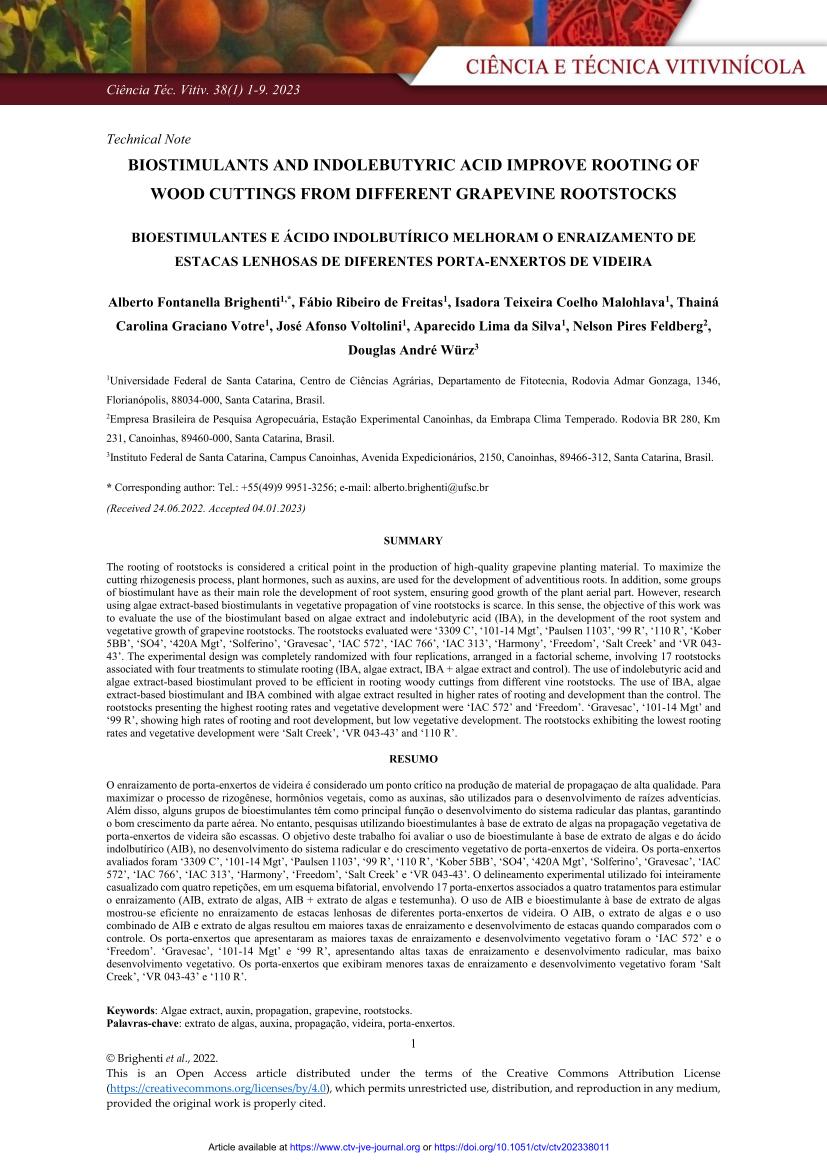 BIOESTIMULANTES E ÁCIDO INDOLBUTÍRICO MELHORAM O ENRAIZAMENTO DE ESTACAS LENHOSAS DE DIFERENTES PORTA-ENXERTOS DE VIDEIRA
BIOESTIMULANTES E ÁCIDO INDOLBUTÍRICO MELHORAM O ENRAIZAMENTO DE ESTACAS LENHOSAS DE DIFERENTES PORTA-ENXERTOS DE VIDEIRA
BIOSTIMULANTS AND INDOLEBUTYRIC ACID IMPROVE ROOTING OF WOOD CUTTINGS FROM DIFFERENT GRAPEVINE ROOTSTOCKS
RESUMO
O enraizamento de porta-enxertos de videira é considerado um ponto crítico na produção de material de propagaçao de alta qualidade. Para maximizar o processo de rizogênese, hormônios vegetais, como as auxinas, são utilizados para o desenvolvimento de raízes adventícias. Além disso, alguns grupos de bioestimulantes têm como principal função o desenvolvimento do sistema radicular das plantas, garantindo o bom crescimento da parte aérea. No entanto, pesquisas utilizando bioestimulantes à base de extrato de algas na propagação vegetativa de porta-enxertos de videira são escassas. O objetivo deste trabalho foi avaliar o uso de bioestimulante à base de extrato de algas e do ácido indolbutírico (AIB), no desenvolvimento do sistema radicular e do crescimento vegetativo de porta-enxertos de videira. Os porta-enxertos avaliados foram ‘3309 C’, ‘101-14 Mgt’, ‘Paulsen 1103’, ‘99 R’, ‘110 R’, ‘Kober 5BB’, ‘SO4’, ‘420A Mgt’, ‘Solferino’, ‘Gravesac’, ‘IAC 572’, ‘IAC 766’, ‘IAC 313’, ‘Harmony’, ‘Freedom’, ‘Salt Creek’ e ‘VR 043-43’. O delineamento experimental utilizado foi inteiramente casualizado com quatro repetições, em um esquema bifatorial, envolvendo 17 porta-enxertos associados a quatro tratamentos para estimular o enraizamento (AIB, extrato de algas, AIB + extrato de algas e testemunha). O uso de AIB e bioestimulante à base de extrato de algas mostrou-se eficiente no enraizamento de estacas lenhosas de diferentes porta-enxertos de videira. O AIB, o extrato de algas e o uso combinado de AIB e extrato de algas resultou em maiores taxas de enraizamento e desenvolvimento de estacas quando comparados com o controle. Os porta-enxertos que apresentaram as maiores taxas de enraizamento e desenvolvimento vegetativo foram o ‘IAC 572’ e o ‘Freedom’. ‘Gravesac’, ‘101-14 Mgt’ e ‘99 R’, apresentando altas taxas de enraizamento e desenvolvimento radicular, mas baixo desenvolvimento vegetativo. Os porta-enxertos que exibiram menores taxas de enraizamento e desenvolvimento vegetativo foram ‘Salt Creek’, ‘VR 043-43’ e ‘110 R’.
SUMMARY
The rooting of rootstocks is considered a critical point in the production of high-quality grapevine planting material. To maximize the cutting rhizogenesis process, plant hormones, such as auxins, are used for the development of adventitious roots. In addition, some groups of biostimulant have as their main role the development of root system, ensuring good growth of the plant aerial part. However, research using algae extract-based biostimulants in vegetative propagation of vine rootstocks is scarce. In this sense, the objective of this work was to evaluate the use of the biostimulant based on algae extract and indolebutyric acid (IBA), in the development of the root system and vegetative growth of grapevine rootstocks. The rootstocks evaluated were ‘3309 C’, ‘101-14 Mgt’, ‘Paulsen 1103’, ‘99 R’, ‘110 R’, ‘Kober 5BB’, ‘SO4’, ‘420A Mgt’, ‘Solferino’, ‘Gravesac’, ‘IAC 572’, ‘IAC 766’, ‘IAC 313’, ‘Harmony’, ‘Freedom’, ‘Salt Creek’ and ‘VR 043- 43’. The experimental design was completely randomized with four replications, arranged in a factorial scheme, involving 17 rootstocks associated with four treatments to stimulate rooting (IBA, algae extract, IBA + algae extract and control). The use of indolebutyric acid and algae extract-based biostimulant proved to be efficient in rooting woody cuttings from different vine rootstocks. The use of IBA, algae extract-based biostimulant and IBA combined with algae extract resulted in higher rates of rooting and development than the control. The rootstocks presenting the highest rooting rates and vegetative development were ‘IAC 572’ and ‘Freedom’. ‘Gravesac’, ‘101-14 Mgt’ and ‘99 R’, showing high rates of rooting and root development, but low vegetative development. The rootstocks exhibiting the lowest rooting rates and vegetative development were ‘Salt Creek’, ‘VR 043-43’ and ‘110 R’.
Autores: Alberto Fontanella Brighenti, Fábio Ribeiro de Freitas, Isadora Teixeira Coelho Malohlava, Thainá Carolina Graciano Votre, José Afonso Voltolini, Aparecido Lima da Silva, Nelson Pires Feldberg and Douglas André Würz
DOI: https://doi.org/10.1051/ctv/ctv202338011













